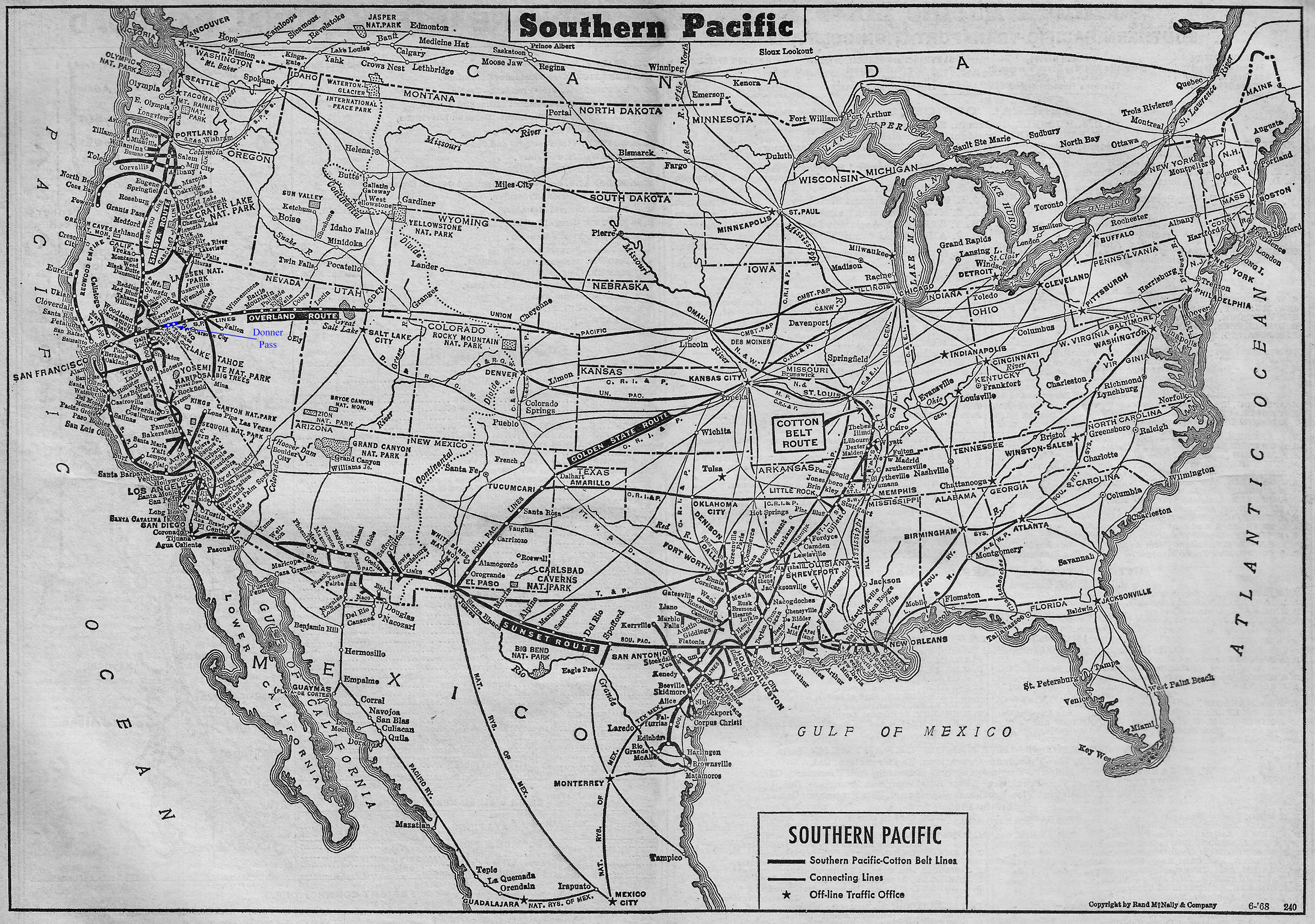- Home ›
- Landmarks ›
- Donner Pass
Donner Pass (Railroad): SP's Sierra-Nevada Crossing
Last revised: October 11, 2023
By: Adam Burns
Donner Pass is a mountain pass in the northern Sierra Nevada, located above Donner Lake about nine miles west of Truckee, California.
It has a steep approach from the east and a gradual approach from the west. The pass has been used by the California Trail, First Transcontinental Railroad, Overland Route, Lincoln Highway and Interstate 80.
The pass gets its name from the ill-fated Donner Party who overwintered there in 1846. The area is known for its challenging railroad routes and is a popular spot for railfans.
Photos
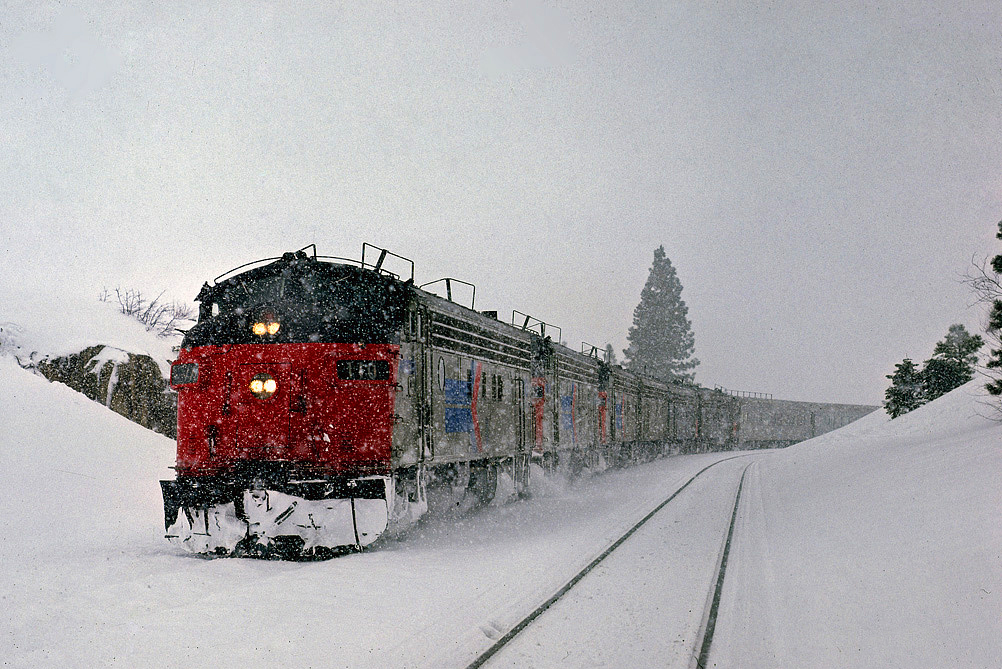 Amtrak FP7 #110 leads the "Reno Fun Train" over Donner Pass at Yuba Pass, California during a February snowstorm in 1975. Drew Jacksich photo.
Amtrak FP7 #110 leads the "Reno Fun Train" over Donner Pass at Yuba Pass, California during a February snowstorm in 1975. Drew Jacksich photo.History
One of the stiffest main lines in the west was Central Pacific's original route over the Sierra Nevada mountain range through Donner Pass, located in east-central California.
Years later the line became part of Southern Pacific's main line to the east where it connected with the Union Pacific at Ogden, Utah.
The route was legendary not only for its stiff grades but also brutal winters. Snowfalls in the Sierras can be staggering and it became a constant struggle for the SP to keep the line open.
This continuous battle with Mother Nature has not lessened with present owner Union Pacific. Despite its operational difficulty the route is a vital artery in UP's system today.
Theodore D. Judah
The line eventually built through Donner Pass was the vision of Theodore D. Judah, an accomplished engineer who surveyed a manageable grade over the Sierra-Nevada range running 115 miles from Sacramento to the Nevada state line.
He lobbied for the project as early as 1859 but was ultimately pushed out by the "Big Four" of Collis P Huntington, Charles Crocker, Leland Stanford, and Mark Hopkins.
Ironically, their Central Pacific ultimately used much of Judah's work and included a total of 15 tunnels blasted out of granite by hand. The Southern Pacific has a whole host of renowned achievements it is credited with, far too many to feature here.
However, its three important main lines continue as important arteries under Union Pacific today; the Overland Route (San Francisco-Chicago), Golden State Route (Southwest-Kansas City), and Sunset Route (Pacific Coast-Gulf Coast).
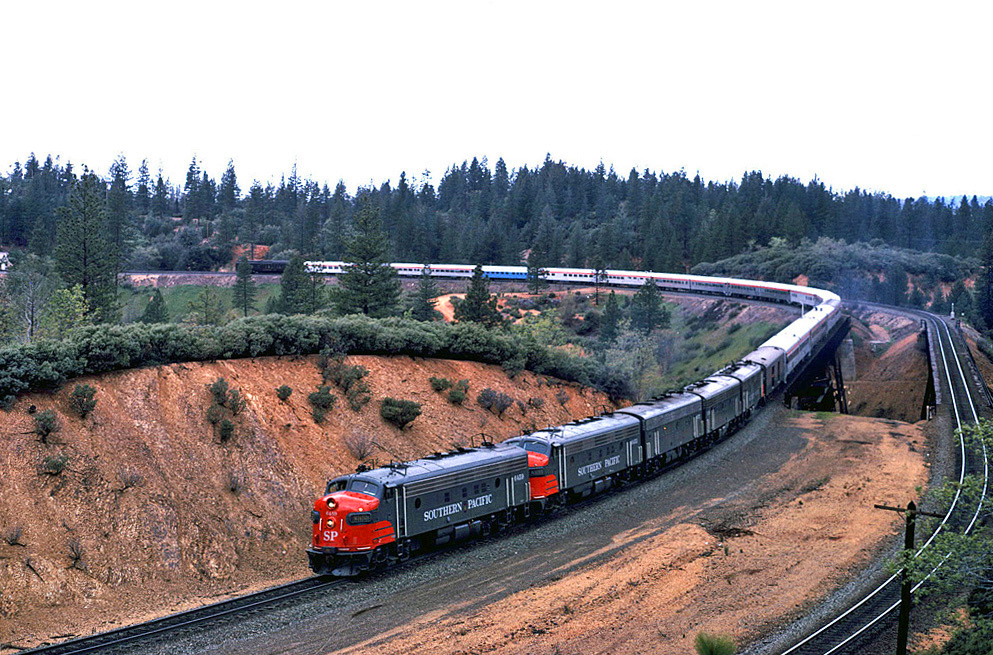 Southern Pacific FP7's have the Pacific Locomotive Association's "Truckee Limited" excursion, the last operated prior to Amtrak, at Long Ravine, California on April 25, 1971. Drew Jacksich photo.
Southern Pacific FP7's have the Pacific Locomotive Association's "Truckee Limited" excursion, the last operated prior to Amtrak, at Long Ravine, California on April 25, 1971. Drew Jacksich photo.The railroad also had numerous famous passenger trains bedecked in its celebrated “Daylight” livery. Many of its trains shared the same name as its paint scheme, Daylights.
These include such names as:
- Coast Daylight
- Sacramento Daylight
- San Joaquin Daylight
- Shasta Daylight
Other notable trains included the Lark, Sunset Limited (still operated by Amtrak), Starlight, San Francisco Overland, City of San Francisco, and the Golden State Limited just to name a few.
While the idea of "Transcontinental Railroad" was authorized in 1862 by Congress, the Central Pacific Railroad was tasked with building the most difficult section; crossing the Sierra Nevadas through eastern California.
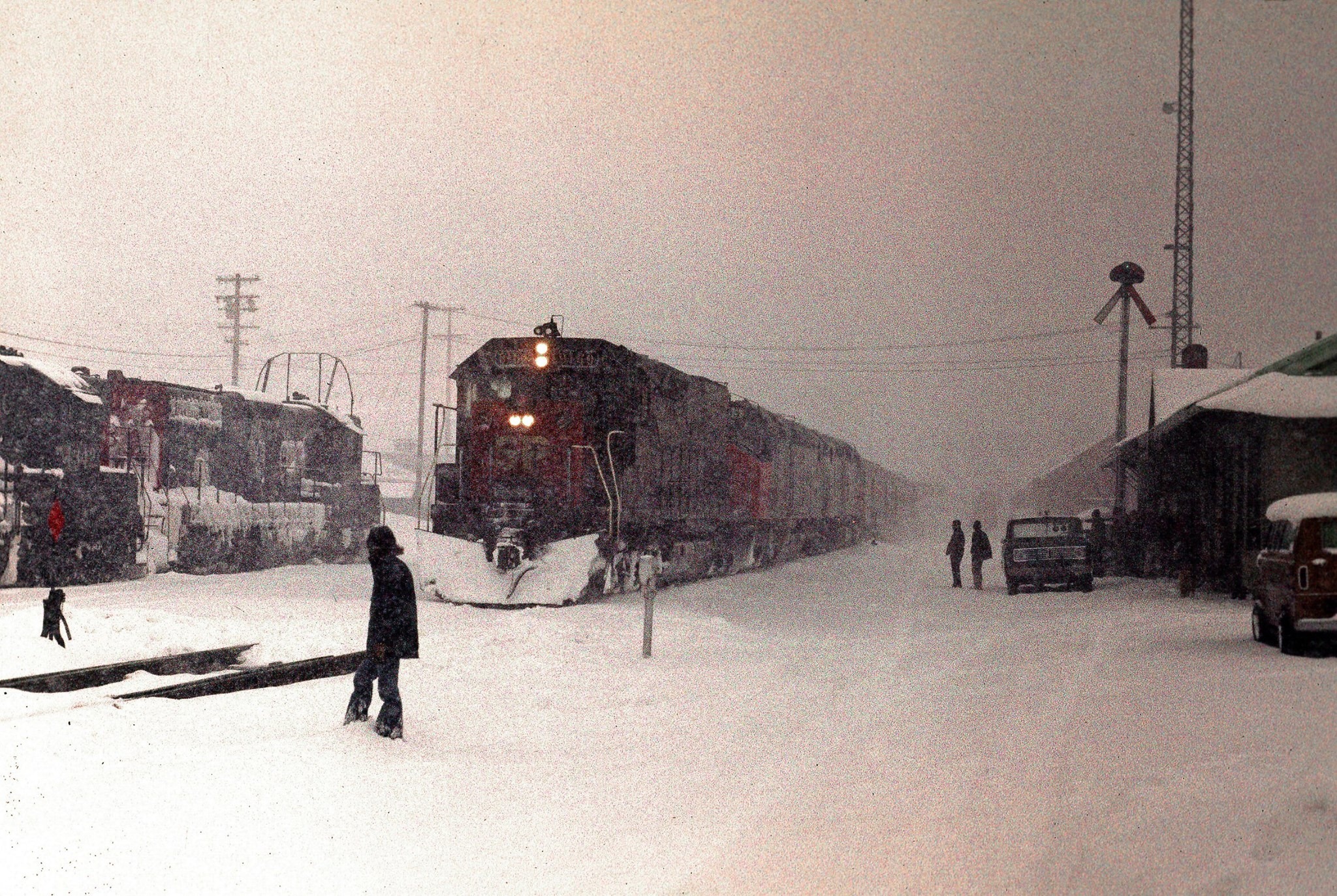 What appears to be a Southern Pacific "Tunnel Motor" is ahead of an Amtrak consist led by SDP40F's at snowbound Truckee, California in February of 1975. Drew Jacksich photo.
What appears to be a Southern Pacific "Tunnel Motor" is ahead of an Amtrak consist led by SDP40F's at snowbound Truckee, California in February of 1975. Drew Jacksich photo.Construction
The Central Pacific began construction in late October, 1863 from Sacramento, California heading east. By September 1, 1865 the CP had completed its line to Colfax along the western edge of the Sierra Nevada range, a distance of about 53 rail miles (according to SP's timetable).
However, surveying and construction through the mountains became much more difficult as there were no roads, or even trails, crews were literally carving a new transportation artery as they went. In doing so they were forced to climb and scale sheer rock faces.
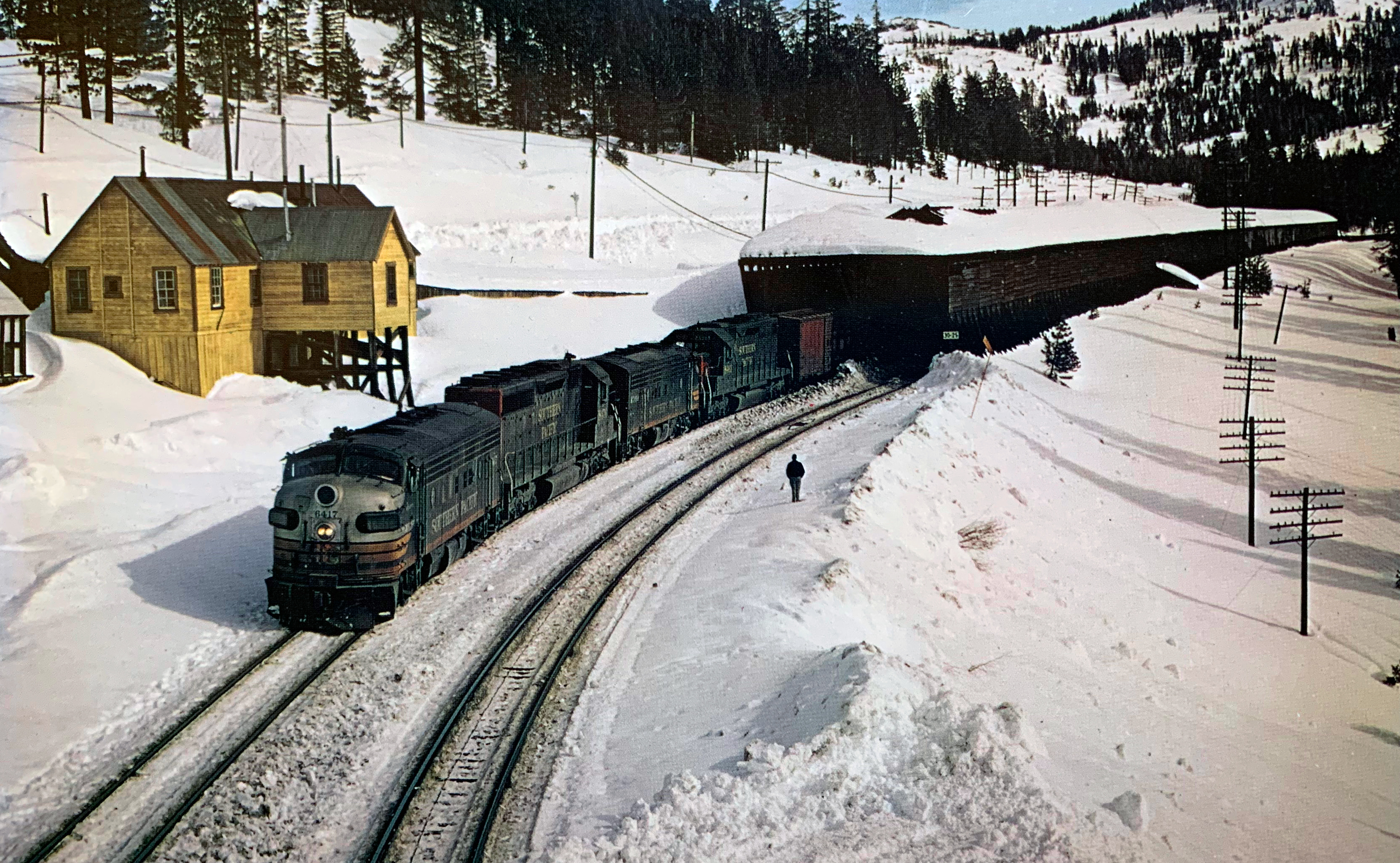 Southern Pacific "Extra 6417," led by F7A #6417, heads west past the cook house as it exits from the snow shed at Norden, California along Donner Pass on January 27, 1967. Referred to as "The Car" by SP employees, the cook house burned down less than a month after this photo was taken. Tom Gildersleeve photo. Author's collection.
Southern Pacific "Extra 6417," led by F7A #6417, heads west past the cook house as it exits from the snow shed at Norden, California along Donner Pass on January 27, 1967. Referred to as "The Car" by SP employees, the cook house burned down less than a month after this photo was taken. Tom Gildersleeve photo. Author's collection.It took the Central Pacific, led by chief assistant engineer, Lewis Clement, more than three years to span the Sierras. The line finally reached "Summit," just west of Truckee (covering a distance of just 65 rail miles) in 1867, with a grade averaging around 2.5%. The line itself did not open until December 13th and included a total of 15 tunnels and numerous snow sheds.
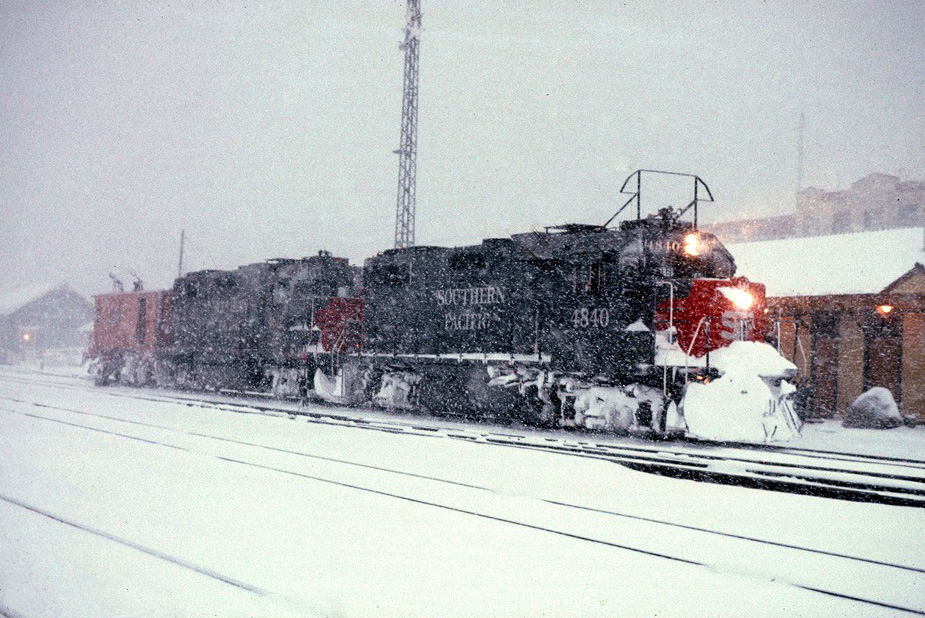 Southern Pacific GP38-2 #4840 and a mate pause next to the depot in Truckee, California with a flanger during January of 1990; the consist will soon make another run over Donner Pass. Drew Jacksich photo.
Southern Pacific GP38-2 #4840 and a mate pause next to the depot in Truckee, California with a flanger during January of 1990; the consist will soon make another run over Donner Pass. Drew Jacksich photo.Operation
Soon after the CP began operations it was acquired by Huntington's Southern Pacific in 1885. In the 1920s SP opened a new line over the Sierra Nevada, which became known as "Track #2."
This line featured a grade between just 1.3% and 2.4%, prompting SP to eventually abandon Track #1 in 1993 to reduce maintenance and operating costs. Today, this route's right-of-way is still easily visible, as are the original tunnels.
Not surprisingly, Donner Pass proved an operating headache with its many tunnels, snow sheds, unpredictable weather, and stiff grades. For railfans who could reach the area during fierce winter storms it offered an amazing spectacle of rotaries battling the weather to keep the line open.
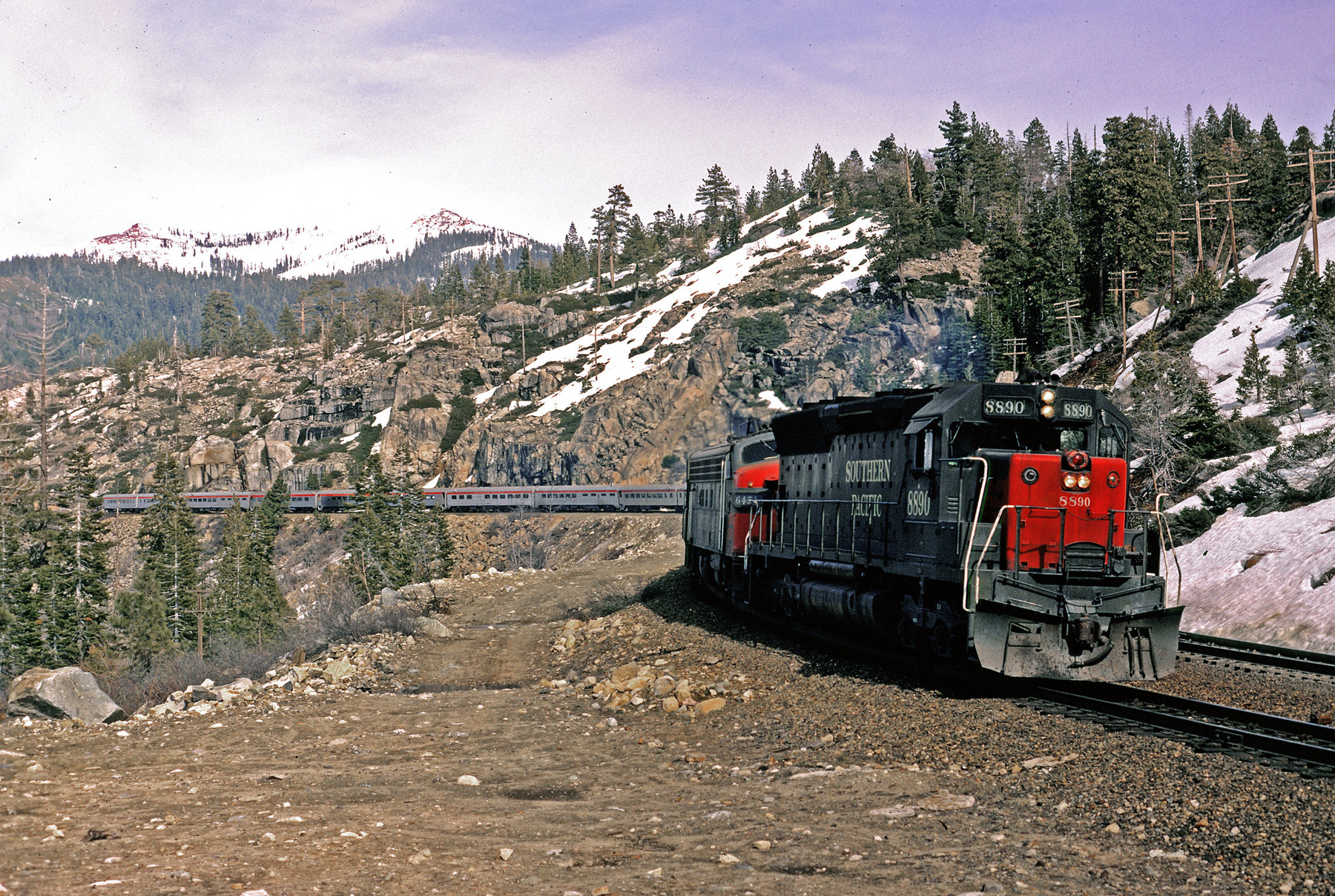 Southern Pacific SD45 #8890 and several FP7's have Amtrak's "Reno Fun Train" traversing Donner Pass at Yuba Gap, California in April of 1972. Drew Jacksich photo.
Southern Pacific SD45 #8890 and several FP7's have Amtrak's "Reno Fun Train" traversing Donner Pass at Yuba Gap, California in April of 1972. Drew Jacksich photo.This line is where the SP developed its most unique steam locomotive the unique 2-8-8-2 "Cab Forward." The locomotive looks much like it’s backward and facing the wrong direction but this design was very deliberate and its purpose was to keep train crews away from the thick smoke and dangerous gases that would build up in the numerous tunnels and snow sheds.
Map
With the development of diesels, SP regularly employed six-axle, C-C designs for maximum tractive effort, usually EMD designs like SD40T-2s and SD45T-2s. Today, the battle with Mother Nature continues with current owner Union Pacific and almost surely will remain so as long as the line remains open.
Tunnels
Tunnel #1: Located at Grizzly Hill, 514.7 feet in length. The bore was widened in 1913 to support double-tracking.
Tunnel #2 (Daylighted): Situated about 1 mile east of Emigrant Gap, this bore was 271 feet in length; daylighted 1923-1924.
Tunnel #3: This bore is at Milepost 180.7 near Cisco. When originally built it was 280 feet in length.
Tunnel #4: Very near Tunnel #3 at Milepost 181, it was originally 92 feet in length.
Tunnel #5 (Daylighted): Located only four miles west of Tunnel #4 at Milepost 185, it was 128 feet in length; daylighted in 1895.
Tunnel #6 (Bypassed): The famous bore in the Sierras also known as "Summit Tunnel" it was 1,659 feet in length. The structure was bypassed in 1997.
Tunnel #7 (Abandoned): Situated at Milepost 194.1 it is 100 feet in length; later daylighted and then covered with a snowshed before being abandoned.
Tunnel #8 (Bypassed): This structure sits at Milepost 194.3 near Black Point. It is 375 feet in length and is no longer in service.
Tunnel #9 (Bypassed): This bore is located at Milepost 194.9 and is 216 feet in length; now abandoned.
Tunnel #10 (Bypassed):This tunnel is at Milepost 195.1 and is 509 feet in length; now abandoned.
Tunnel #11 (Bypassed): Based at Milepost 195.4 it is 577 feet in length, now abandoned.
Tunnel #12 (Bypassed): At Milepost 195.7 it is only a mile west of Tunnel #11; the structure is 342 feet in length and is now abandoned.
Tunnel #13: Situated at Milepost 200.1 near Andover it is the second-longest at 870 feet in length.
Tunnel #14 (Bypassed): Located at Milepost 222 it is 200 feet in length and was bypassed following a line change in 1913.
Tunnel #15 (Daylighted): Located at milepost 225 (Quartz Spur); originally 96 feet in length. The bore was daylighted in 1895 and the grade was abandoned in 1913 following a line change.
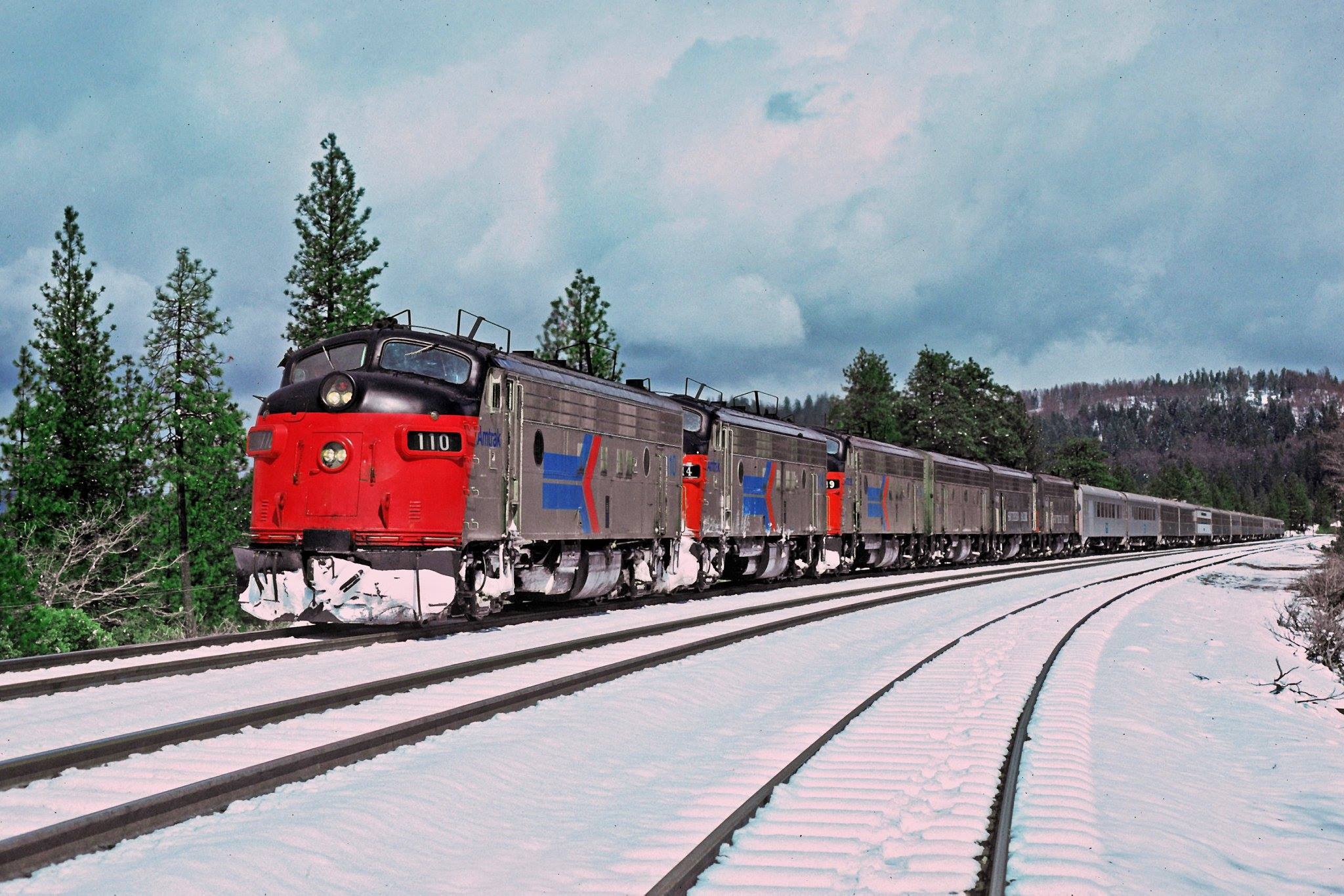 Amtrak's westbound "Reno Fun Train" is led by a parade of "covered wagons" as it rolls across the west side of Donner Pass at Gold Run, California in February, 1975. Drew Jacksich photo.
Amtrak's westbound "Reno Fun Train" is led by a parade of "covered wagons" as it rolls across the west side of Donner Pass at Gold Run, California in February, 1975. Drew Jacksich photo.Today
Currently operations with what modern-day locomotives, many of which are General Electric-built, are not nearly as exciting as watching Cab Forwards conquer the pass although they are certainly much more economical and provide the railroad with a tremendous savings in operating costs.
The issues poised by snow will always remain and as a result will always require the use of multiple snowsheds for more fluid operations.
If you would like to see the pass in action today, it is much easier to access than during the pre-Interstate era; simply take Interstate 80 anywhere between Colfax and Truckee, California as it closely parallels the line all across the mountain.
SteamLocomotive.com
Wes Barris's SteamLocomotive.com is simply the best web resource on the study of steam locomotives.
It is difficult to truly articulate just how much material can be found at this website.
It is quite staggering and a must visit!

